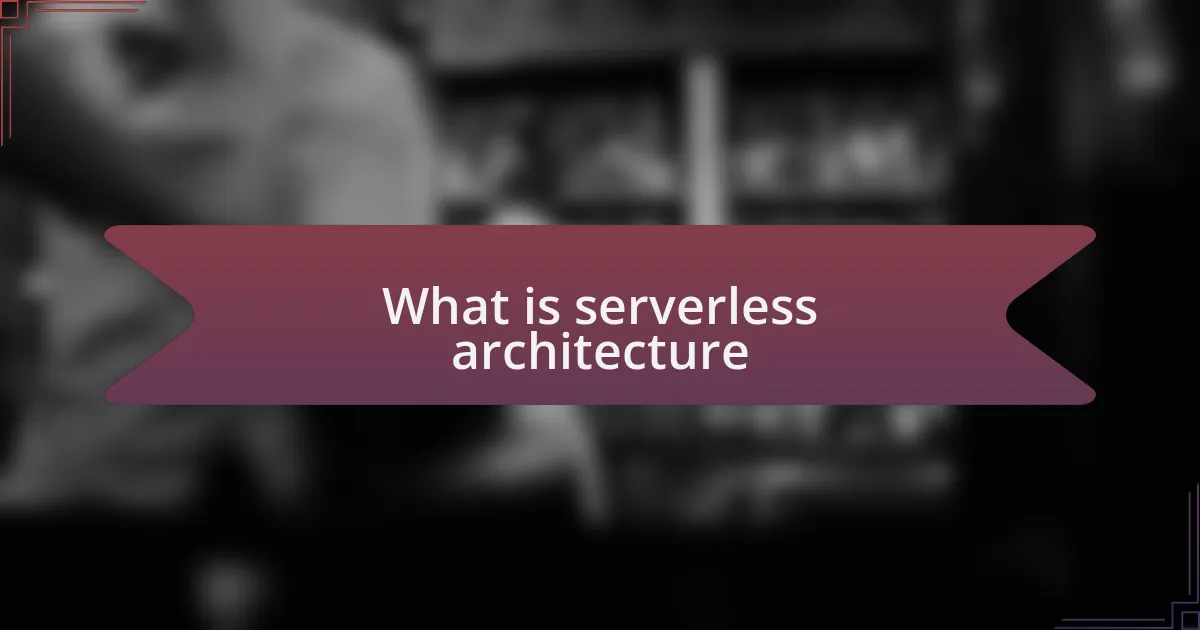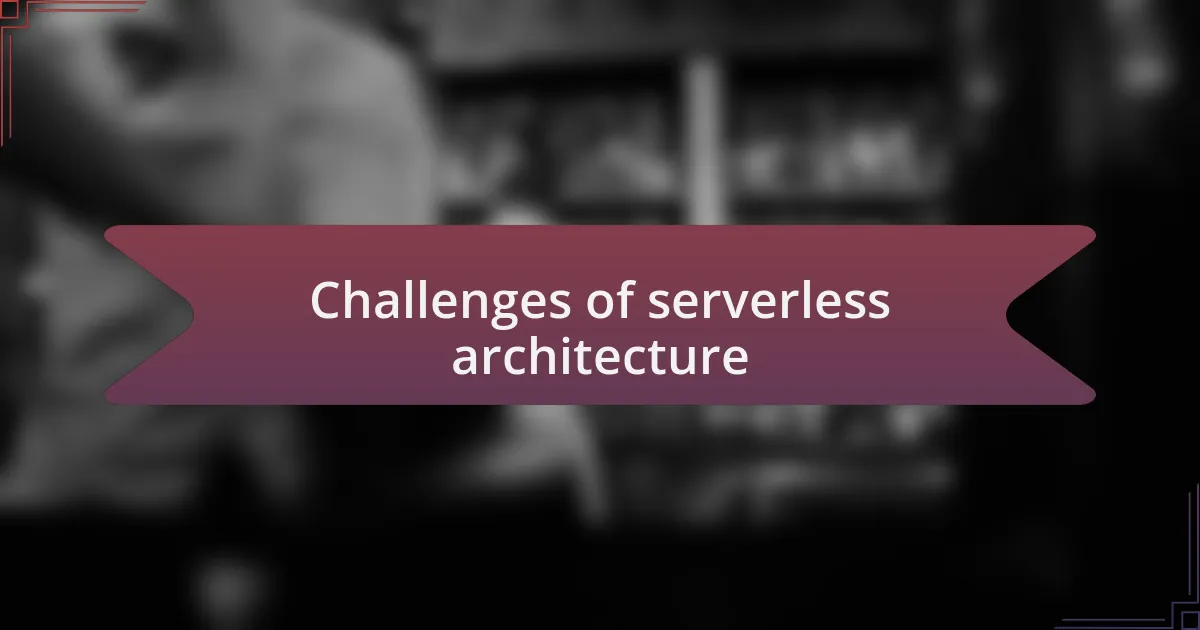Key takeaways:
- Serverless architecture abstracts server management, allowing developers to focus on coding while the cloud provider handles infrastructure maintenance, scaling, and deployment.
- Key benefits include rapid deployment, automatic scalability, and cost efficiency, with charges based solely on actual usage, fostering innovation and faster development cycles.
- Challenges include cold starts affecting performance, security vulnerabilities due to lack of traditional measures, and concerns regarding vendor lock-in.
- The future of serverless architecture is promising, driven by increased adoption, integration with AI/ML, and a movement towards multi-cloud strategies to avoid vendor dependency.

What is serverless architecture
Serverless architecture, despite its name, doesn’t mean there are no servers involved; instead, it abstracts away server management. Essentially, developers can focus on writing code while the cloud provider handles the deployment, scaling, and maintenance of the infrastructure. I still remember the first time I deployed a microservice in a serverless environment—it felt liberating to let go of infrastructure worries and dive straight into crafting features.
In a serverless model, you pay only for the compute power you use, which can lead to cost savings compared to traditional servers. This pay-as-you-go approach resonates with many developers, sparking a sense of excitement about managing resources more efficiently. Have you ever felt the thrill of optimizing costs while improving performance? That’s exactly what serverless can offer you.
Moreover, serverless architecture encourages a more modular approach to application design. By breaking down applications into smaller, event-driven functions, I find that teams can develop, test, and deploy features faster. Isn’t it fascinating how this approach fosters innovation? It not only accelerates development cycles but also empowers teams to rapidly iterate based on user feedback.

Benefits of serverless architecture
When I first transitioned to serverless architecture, I was taken aback by the sheer speed of deployment. Instead of navigating complex server setups, I could focus on creating features that truly mattered to users. Have you ever experienced that “aha” moment when a project comes together much more quickly than expected? That’s one of the remarkable benefits of serverless—it often enables rapid iteration and feedback cycles, which can be a game-changer for teams.
Another significant advantage I’ve found is scalability. With traditional servers, predicting traffic spikes can be a headache—remember that one time when your website went down during a promotional event? In a serverless framework, the cloud provider automatically manages scaling for you. It’s a relief to know that your application can accommodate visitors without additional configuration on your part.
Cost efficiency truly stands out in serverless architecture. Initially, I was skeptical about how this model could save money over time. But seeing firsthand how charges are based on actual usage rather than pre-allocated resources changed my perspective. It feels empowering to know that as usage increases, costs align more closely with value, making it a sustainable option for businesses of all sizes.

Use cases for serverless architecture
When I consider serverless architecture, I can’t help but think of its ideal fit for event-driven applications. For instance, I once developed a photo processing app that relied on serverless functions to handle uploads. The beauty of it was how seamlessly it processed images as users uploaded them, allowing for real-time feedback without the constraints of traditional server management. Isn’t it invigorating to witness an application come to life without the constant worry of capacity planning?
Another brilliant use case involves APIs and microservices. I remember building a lightweight API for a mobile app that needed to fetch data on demand. By opting for a serverless architecture, I saved a considerable amount of time and energy, allowing me to focus on enhancing user experience rather than wrestling with server configurations. Who wouldn’t appreciate a solution that simplifies complexity while boosting efficiency?
E-commerce platforms also thrive on the flexibility of serverless architecture during peak shopping events. I recall one holiday season where an online store I was involved with faced overwhelming traffic. Leveraging serverless functions meant that we could handle thousands of simultaneous requests without a hitch. How powerful it felt to know we could serve every customer without any hiccups or downtime, all thanks to the scalability inherent in serverless solutions!

Challenges of serverless architecture
When I dive into the challenges of serverless architecture, one concern stands out: cold starts. I’m sure many developers can relate to the frustration when a serverless function takes longer to respond than expected due to it being idle. On a project where I needed rapid response times for a chat application, I found that the latency introduced during these cold starts negatively impacted user experience. Isn’t it disheartening to see your carefully crafted application pause due to something seemingly trivial?
Security is another tricky aspect. While the serverless model abstracts server management, it also introduces an entirely new set of vulnerabilities. I once worked on a project that involved sensitive user data, and I was acutely aware of the risks associated with inadequate security configurations. It made me wonder—how do you safeguard your application without traditional security measures? In my experience, leveraging proper authentication and network isolation is crucial, but it also requires a continuous commitment to monitoring and adapting.
Lastly, vendor lock-in can be a significant concern when committing to a serverless provider. I recall a painful lesson learned when a project relied heavily on one cloud provider’s proprietary tools. When the time came to scale or switch due to evolving business needs, migrating away became a daunting challenge. Have you ever felt tied down by a tool that no longer serves your needs? In the end, I realized the importance of planning for portability from the beginning, even within a serverless approach.

My personal experience with serverless
My journey with serverless architecture began with palpable excitement. I remember the first time I deployed a function to handle file uploads for a web application. The ease of scaling and the reduction in infrastructure management were exhilarating. However, I quickly discovered the delicate balance between that excitement and the reality of managing dependencies and execution time limits. Have you ever felt that excitement turn to anxiety when you realize how easily things can go wrong?
On another project, I encountered the blissful simplicity of serverless while building a personal blog. The deployment process was a breeze, allowing me to focus on content rather than server configurations. Yet, I often found myself reflecting on the trade-offs. Did the freedom of coding in a serverless environment mean sacrificing control over performance tuning? The freedom to innovate was undeniably appealing, but it came with its own set of challenges that had me reconsidering the implications of that choice.
Furthermore, the community around serverless technology has been inspiring. I joined online forums to exchange insights with fellow developers and enthusiasts, and the support I received was invaluable. Participating in discussions about best practices and pitfalls truly enhanced my learning experience. Have you ever felt a sense of belonging in a community that shares your passion? Embracing serverless architecture has not only transformed the way I build applications but has also connected me with many like-minded individuals who enrich my journey.

Best practices for implementing serverless
When implementing serverless architecture, one of the most crucial best practices is to optimize for cold starts. I’ve learned, often the hard way, that functions can take longer to execute when they’re not frequently invoked. Have you ever faced longer-than-expected execution times during peak usage? By reducing the number of dependencies in your code or leveraging provisioned concurrency, you can significantly enhance performance.
Another tip is to monitor usage and performance metrics diligently. I often found myself surprised by unexpected costs when functions would trigger more frequently than anticipated. Regularly analyzing these metrics has not only helped me manage costs better but also fine-tune performance. Have you ever felt that thrill of discovering insights in data that directly improve your application?
Additionally, writing infrastructure-as-code can be a game changer. In my experience, using tools like Terraform or AWS CloudFormation has allowed me to version control my serverless setups. This practice not only enhances collaboration within teams but also provides a safety net when deploying new features. Do you think having a reliable backup plan can ease the stress of deployment? I sure do, and it’s one practice I wish I had adopted earlier in my serverless journey.

Future of serverless architecture
The future of serverless architecture is bright and full of potential. As I see it, the trend is shifting toward greater adoption due to its ability to streamline development processes. Can you imagine a scenario where developers focus more on building features than managing infrastructure? I’ve certainly felt that freedom; it’s exhilarating to leverage a model where scaling happens automatically, as long as the underlying technology evolves to support such demand.
With the rise of artificial intelligence and machine learning, serverless architecture is poised to play a crucial role in enabling sophisticated applications. I recall working on a project where integrating AI models into a serverless environment eliminated numerous bottlenecks associated with traditional architectures. It was enlightening to discover how seamlessly the serverless model can handle varying workloads while offering cost efficiency. Isn’t it fascinating how innovations can simplify complex tasks, allowing us to innovate faster?
As we look ahead, I believe serverless will increasingly tie into multi-cloud strategies. My experience has shown me that businesses are keen on avoiding vendor lock-in while taking advantage of distinct services offered by various providers. This opens up opportunities for more flexible, resilient applications. Have you experimented with deploying across multiple clouds? It can be rewarding, though I’ve learned that managing these environments requires a different level of strategy and oversight.